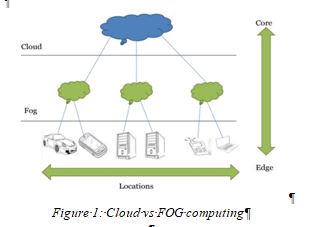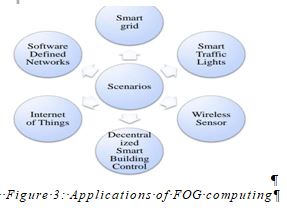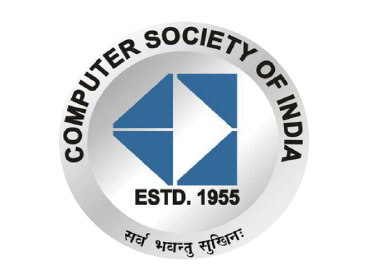Fog Computing
Faculty Mentor:
Dr.Chetna Loraiya
Student Name:
Nisha Negi(MCA - 1st Year)
Varsha Saxena(MCA - 1st Year)
1. INTRODUCTION
We are embracing the spread of throughout connected smart devices, which is now becoming the main factor of computing.With the development of wearable computers, smart meter technology, attached vehicles and large-scale wireless sensor network, the internet of things is becoming advanced day by day and is receiving attentions for years.Thus, it is considered as the future of Internet.
FOG computing bridges the gap between the cloud and end devices (e.g., IoT nodes) by enabling computing, storing, networking, and data management on network nodes within the close vicinity of IoT Devices. FOG computing is a fragmentation of computing in which data, perminant information and applications are placed somewhere between the source of data and the cloud. In the similar way of edge computing, FOG computing also consists of so many advantages and power of the cloud closer to which data is developed and acted upon. FOG computing was introduced by the Cisco. An open source Linux and network OS were combined in a single network device.It was bought by Cisco. Users can implement, manage and run software applications on Cisco framework of networked devices, including hardened routers and switches.
2.WORKING OF FOG COMPUTING
It is very neccessary to note that FOG networking does not replaces cloud computing.As we all know fog notes are basically routers,controllers,switches and video camera.They are used for some special goal or target such as within vehicle or in office floor.Whenever any data is generated by internet of things, then it is analysed bynodes, only without sending directly to clouds.It act as an intermediate layer to store data or any other relevant information.Steps involved:
- Signal received from IOT devices and controllers execute a program
- This control system sends data by protocol gateways.
- Now the data is transformed to protocol which is understand more easily and effectively.
- At last data is sent to fog nodes which stores the data for future uses.

3.WHEN TO USE FOG COMPUTING OVER CLOUD COMPUTING
- Data is collected at the maximum edge :transports such as ships,factory floors,roadways,railways,etc.
- Millions of things across a huge geographic area are developing data.
- It is very important to examine and act on the data in very less time.
4.TOOL USED IN FOG COMPUTING (iFogSim)
It is an open source toolkit used in FOG computing which is used to stimulate networks of FOG computing. The following are the iFogSim requirements to stimulate the network:
- Fog Device
- Sensor
- Acuator
- Tuple
- Application
- Monitoring Edge
- Resource Management Service
5.APPLICATIONS OF FOG COMPUTING
Haze registering works best in a cloud-based control condition which offers further understanding crosswise over hubsby and large incorporate transportation, shrewd urban areas, wind vitality and brilliant structures. Presently we have models which we use in our everyday life: -
Fog Computing in Smart Building:
Shrewd structurere control remote sensors which estimates temperature, moistness and different vaporous segments in structure environment.FOG Computing in Smart Traffic Light:
In this there are video cameras which senses ambulance flashing light and can automatically turns the signal green. In this way critical patients faces no traffic problem. In this way FOG computing helps a lot.Wireless Sensor and Actuator Networks (WSAN):
The genuine Remote Sensor Hubs (WSNs), were intended to expand battery life by working at low control. Actuators fills in as Haze gadgets which control the estimating procedure itself, the consistency and the oscillatory practices through making a shut circle framework.Smart Grids:
Brilliant lattice is another application where Haze registering has been utilized. In light of interest for vitality, it’s got capacity and minimal effort, these savvy gadgets can change to different energies like sun oriented and winds.Self-Maintaining Train:
Another utilization of Mist processing is in self looking after trains. A train metal roller checking sensor will detect the adjustments in the temperature level and any turmoil will consequently alarm the train administrator and make upkeep as indicated by. Accordingly, we can dodge serious fiascos.

6.ADVANTAGES OF FOG COMPUTING
- Privacy Control: With fog computing, you can better control the level of privacy. You can process and analyze sensitive data locally rather than having to sending them to a centralized cloud for analysis. By keeping the process local, the IT team can monitor, track, and control any device that collects or stores data.
- Increased Business Productivity and Agility: Fog computing helps improve productivity and increase the speed of business processes.They can allow retrieval of only those data that require immediate human interaction rather than all data, reducing the time and effort required to find potential issues. Fog computing has the potential to save your business time and money by decreasing your IT managers’ workload.
- DataSecurity: Data security is among the most important aspects of business. Fog computing allows you to connect multiple devices to a network.Rather than one centralized location that may become vulnerable, activity takes place between various local endpoints, making it easier to identify threats such as infected files, potential hacks, or malware and the threats are identified much earlier and can be contained at the device level instead of infecting or risking the whole network.
7.DRAWBACK OF FOG COMPUTING
- Existing information insurance components as encryption flopped in verifying the information from the aggressorsdoes not verify whether the user was authorized or not.
- Distributed computing security doesn't concentrate on verifying the information from unapproved get to.
- For some, the whole concept of fog computing seems complex and confusing. A system that includes many devices that store and analyse their own data and that could be located anywhere, at any time adds complexity to a network that once sent all its data to a centralized location.
- With numerous devices and therefore numerous users, the risk for corrupted or infected files, apps, or information leaking into the company’s main data stream dramatically increases. Employees probably don’t use their devices specifically for work, increasing the potential risks to both the device and the company.
- Using fog computing, a large volume of data is stored on the devices themselves. These devices are often located outside the office’s physical location, and many companies or business managers feel that this configuration increases the risk of a data breach or hack.
8.CONCLUSION
Haze processing preferences for administrations in a few domains,such as Savvy Grid,wireless sensor networks,Interent of Things and programming characterized networks.We analyze the cutting edge and uncover some broad issues in Mist figuring including security,privacy,trust,and administration movement among Haze gadgets and among Haze and cloud.
9.REFERENCE
[1]https://it.toolbox.com/blogs/
carmashoemaker/fog-computing-what-is-it-and-what-are-its-advantages-and-disadvantages-010819
[2]https://www.iqvis.com/blog/fog-computing-advantages-examples/
[3]https://www.sciencedirect.com/
science/article/pii/S13837621183
06349#sec0010
[4]http://www.ijcea.com/applications-fog-computing-iot/





